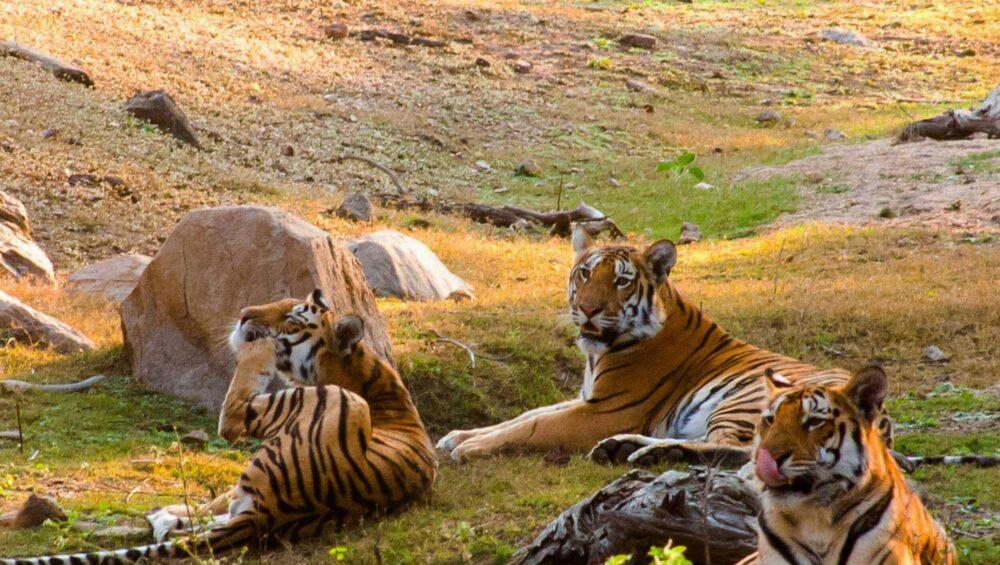Nestled in the heart of India, Pench National Park stands as a testament to the country’s rich biodiversity and natural beauty. Located in the Seoni and Chhindwara districts of Madhya Pradesh, Pench National Park spans an area of approximately 758 square kilometers, making it one of the premier wildlife destinations in India. This magnificent park is named after the Pench River, which meanders through the park, adding to its scenic beauty and providing a lifeline for its diverse flora and fauna. In this blog, we will delve deep into the wonders of Pench National Park, exploring its history, biodiversity, and the unique experiences it offers to visitors.
A Glimpse into History
Pench National Park’s rich history dates back to the 16th century, with its mention in the Ain-i-Akbari, a document detailing the administration of Emperor Akbar’s empire. However, it gained widespread recognition due to its association with Rudyard Kipling’s timeless classic, “The Jungle Book.” The park is believed to have inspired Kipling’s depiction of the Seoni Hills and the adventures of Mowgli, Baloo, Bagheera, and Shere Khan. This literary connection has made Pench an iconic destination for fans of the book and nature lovers alike.
Biodiversity at its Best
Pench National Park is renowned for its remarkable biodiversity. The park is home to a variety of ecosystems, including dry deciduous forests, tropical moist deciduous forests, and grasslands. This diverse range of habitats supports an impressive array of wildlife species, making it a paradise for wildlife enthusiasts and photographers.
Mammals
The park’s most celebrated resident is the Bengal tiger (Panthera tigris tigris). Pench is part of the larger Pench Tiger Reserve, which spans Madhya Pradesh and Maharashtra. The reserve is known for its healthy tiger population, and visitors have a good chance of spotting these majestic predators in their natural habitat. In addition to tigers, Pench is home to other large carnivores such as leopards (Panthera pardus), Indian wild dogs (Cuon alpinus), and sloth bears (Melursus ursinus).
Herbivores are also abundant in Pench, with species like the Indian gaur (Bos gaurus), sambar deer (Rusa unicolor), spotted deer (Axis axis), and barking deer (Muntiacus muntjak) commonly seen. These herbivores play a crucial role in maintaining the park’s ecological balance by serving as prey for the park’s apex predators.
Birds
Pench National Park is a birdwatcher’s paradise, with over 250 bird species recorded within its boundaries. The park’s varied habitats provide a haven for both resident and migratory birds. Some of the notable bird species found here include the Indian pitta (Pitta brachyura), Malabar pied hornbill (Anthracoceros coronatus), crested serpent eagle (Spilornis cheela), and the white-eyed buzzard (Butastur teesa). The Pench River and its surrounding wetlands attract a plethora of waterfowl, including herons, egrets, and kingfishers.
Reptiles and Amphibians
The park’s reptilian inhabitants are equally fascinating, with several species of snakes, lizards, and turtles calling Pench home. The Indian rock python (Python molurus) and the Bengal monitor lizard (Varanus bengalensis) are among the notable reptile species found here. Amphibians such as frogs and toads are also present, particularly in the park’s moist areas.
Flora
Pench’s diverse flora is a vital component of its ecosystem. The park’s forests are dominated by teak (Tectona grandis), sal (Shorea robusta), and various species of bamboo. These forests provide essential shelter and food for the park’s wildlife. In addition to the trees, Pench is home to a variety of shrubs, grasses, and medicinal plants, making it a botanist’s delight.
Safari Experience
One of the most exciting ways to explore Pench National Park is through a safari. The park offers both jeep and elephant safaris, each providing a unique perspective on the park’s wildlife and landscapes.
Jeep Safaris
Jeep safaris are the most popular way to explore Pench. They allow visitors to cover a large area of the park and increase the chances of spotting wildlife. The park is divided into several zones, with the Turia and Karmajhiri gates being the most frequently visited. Jeep safaris are usually conducted in the early morning and late afternoon when animals are most active. Trained naturalists accompany the safaris, providing valuable insights into the park’s flora and fauna.
Elephant Safaris
For a more immersive experience, visitors can opt for an elephant safari. Riding on the back of an elephant allows for a closer encounter with the park’s wildlife and a unique vantage point for photography. Elephant safaris are particularly popular for tiger tracking, as these gentle giants can navigate through dense forests and tall grasslands where jeeps cannot venture.
Conservation Efforts
Pench National Park has been at the forefront of wildlife conservation efforts in India. The park’s management focuses on preserving its biodiversity and ensuring the long-term survival of its iconic species, particularly the Bengal tiger. Anti-poaching measures, habitat restoration, and community involvement are integral to the park’s conservation strategy.
The park also collaborates with various non-governmental organizations (NGOs) and research institutions to monitor wildlife populations and study their behavior. These efforts have yielded valuable data that aids in the effective management of the park’s resources.
Ecotourism and Community Involvement
Ecotourism plays a vital role in Pench National Park’s conservation efforts. By promoting responsible tourism, the park aims to create awareness about wildlife conservation and generate revenue for local communities. Several eco-friendly lodges and resorts have been established around the park, providing comfortable accommodations while minimizing their environmental impact.
Local communities are actively involved in the park’s ecotourism initiatives. Many villagers work as guides, naturalists, and staff at the lodges, benefiting from the economic opportunities created by tourism. This community involvement fosters a sense of ownership and responsibility towards the park’s conservation.
Practical Information for Visitors
Best Time to Visit
Pench National Park is open to visitors from October to June, with the peak season being from November to March. During this period, the weather is pleasant, and wildlife sightings are more frequent. The park remains closed during the monsoon season (July to September) to protect the wildlife and allow the forest to regenerate.
Getting There
The nearest airport to Pench National Park is Dr. Babasaheb Ambedkar International Airport in Nagpur, Maharashtra, approximately 93 kilometers away. From Nagpur, visitors can hire taxis or take buses to reach the park. The nearest railway stations are Seoni and Nagpur, both well-connected to major cities in India.
Accommodation
Several accommodation options are available around Pench National Park, ranging from luxury resorts to budget-friendly lodges. Some popular choices include Pench Jungle Camp, Tuli Tiger Corridor, and Taj Baghvan. These establishments offer a range of amenities, including guided safaris, nature walks, and birdwatching tours.
Conclusion
Pench National Park is a treasure trove of biodiversity, offering a glimpse into the wild heart of India. Its rich history, diverse flora and fauna, and commitment to conservation make it a must-visit destination for nature enthusiasts. Whether you’re tracking tigers on a jeep safari, observing birds in their natural habitat, or simply soaking in the tranquility of the forest, Pench promises an unforgettable wildlife experience. As you explore this enchanting park, you’ll gain a deeper appreciation for the wonders of nature and the importance of preserving these precious ecosystems for future generations.






